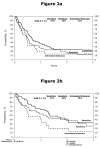Unrelated donor reduced-intensity allogeneic hematopoietic stem cell transplantation for relapsed and refractory Hodgkin lymphoma
- PMID: 19135949
- PMCID: PMC2929570
- DOI: 10.1016/j.bbmt.2008.11.011
Unrelated donor reduced-intensity allogeneic hematopoietic stem cell transplantation for relapsed and refractory Hodgkin lymphoma
Abstract
Myeloablative allogeneic hematopoietic cell transplantation (HCT) may cure patients with relapsed or refractory Hodgkin lymphoma (HL), but is associated with a high treatment-related mortality (TRM). Reduced-intensity and nonmyeloablative (RIC/NST) conditioning regimens aim to lower TRM. We analyzed the outcomes of 143 patients undergoing unrelated donor RIC/NST HCT for relapsed and refractory HL between 1999 and 2004 reported to the Center for International Blood and Marrow Transplant Research (CIBMTR). Patients were heavily pretreated, including autologous HCT in 89%. With a median follow-up of 25 months, the probability of TRM at day 100 and 2 years was 15% (95% confidence interval [CI] 10%-21%) and 33% (95% CI 25%-41%), respectively. The probabilities of progression free survival (PFS) and overall survival (OS) were 30% and 56% at 1 year and 20% and 37% at 2 years. The presence of extranodal disease and the Karnofsky Performance Scale (KPS) <90 were significant risk factors for TRM, PFS, and OS, whereas chemosensitivity at transplantation was not. Dose intensity of the conditioning regimen (RIC versus NST) did not impact outcomes. Unrelated donor HCT with RIC/NST can salvage some patients with relapsed/refractory HL, but relapse remains a common reason for treatment failure. Clinical studies should be aimed at reducing the incidence of acute graft-versus-host disease (GVHD) and relapse.
Figures


References
-
- Aisenberg AC. Problems in Hodgkin disease management. Blood. 1999;93:761–779. - PubMed
-
- Johnston LJ, Horning SJ. Autologous hematopoietic cell transplantation in non-Hodgkin lymphoma. Hematol Oncol Clin North Am. 1999;13:889–918. - PubMed
-
- Josting A, Rueffer U, Franklin J, et al. Prognostic factors and treatment outcome in primary progressive Hodgkin lymphoma: a report from the German Hodgkin Lymphoma Study Group. Blood. 2000;96:1280–1286. - PubMed
-
- Schmitz N, Pfistner B, Sextro M, et al. Aggressive conventional chemotherapy compared with high-dose chemotherapy with autologous haemopoietic stem-cell transplantation for relapsed chemosensitive Hodgkin disease: a randomised trial. Lancet. 2002;359:2065–71. - PubMed
-
- Tarella C, Cuttica A, Vitolo U, et al. High-dose sequential chemotherapy and peripheral blood progenitor cell autografting in patients with refractory and/or recurrent Hodgkin lymphoma: a multicenter study of the intergruppo Italiano Linfomi showing prolonged disease free survival in patients treated at first recurrence. Cancer. 2003;97:2748–2759. - PubMed
Publication types
MeSH terms
Grants and funding
LinkOut - more resources
Full Text Sources
Medical

